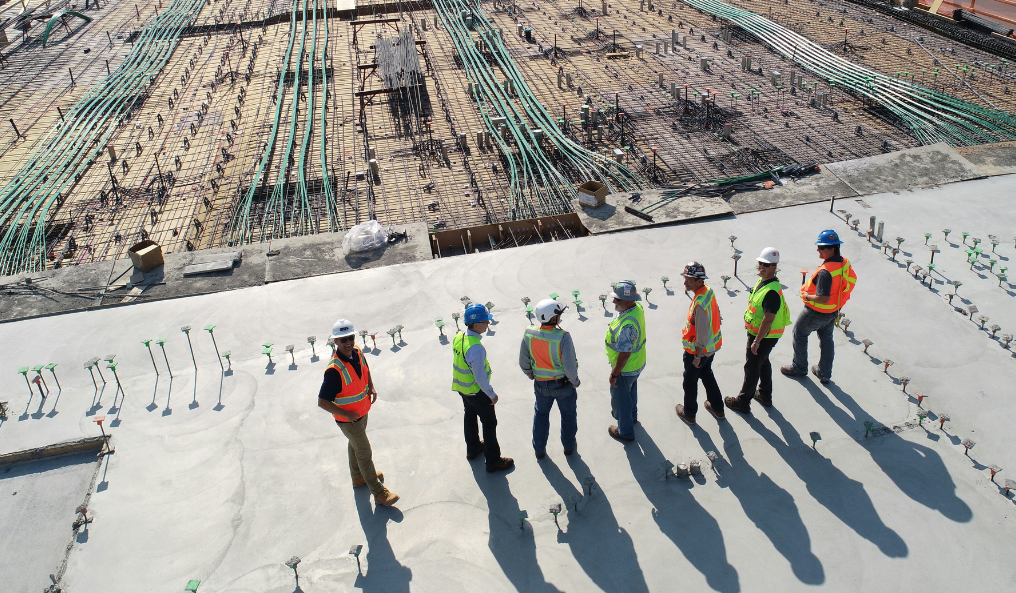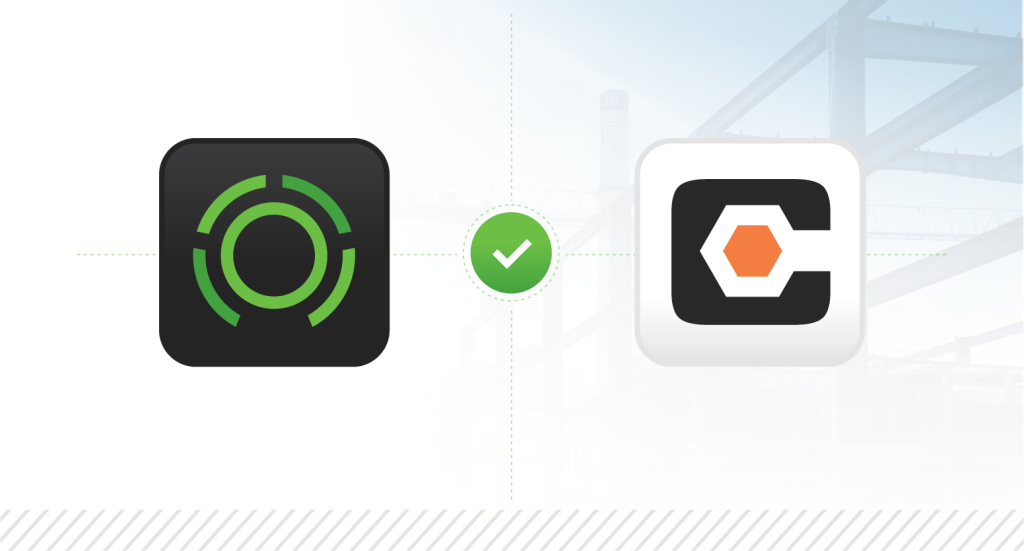Investing in quality construction safety management is not only a regulatory requirement, but also a strategic investment that can help lead to better project outcomes. On average, construction site injuries cost $35,000 in direct and indirect costs, including lost time. Studies have found that every $1 invested in safety management can lead to $3-$6 of long-term savings by reducing the frequency of incidents and improving productivity.
Let’s review what construction safety management is and how you can implement modern safety protocols at your jobsite!
What Is Construction Safety Management?
Construction safety management is the process of implementing and overseeing safety policies and protocols on a construction site to ensure the well-being of workers, contractors, and the public. It involves identifying potential hazards, assessing risks, and implementing preventive measures to mitigate accidents and injuries.
Key components of construction safety management include:
- Regular safety training
- Use of personal protective equipment (PPE)
- Adherence to regulatory standards
- Continuous risk assessment
- Ongoing monitoring of site conditions to promptly address any safety concerns
- Regulatory audits conducted by OSHA and other occupational safety administrations
Effective construction safety management is crucial not only for protecting workers but also for maintaining project timelines and budgets. By proactively managing safety risks, construction companies can reduce the likelihood of costly delays and legal issues arising from workplace accidents. This approach ensures that safety is integrated into every phase of the construction process, from planning and design to execution and completion.
Tips for Optimizing Construction Safety Management
Construction safety management has received significant investment in recent years. New tools, best practices, and software have enabled project managers to implement safety protocols more efficiently and effectively, enhancing overall risk management, project safety and compliance.
Below, you’ll learn the top 5 ways to create efficiencies in construction safety management and gain tips for implementing safety best practices.
1. Implement Technology Solutions

Leveraging technology is one of the most effective ways that you can streamline your processes. New technology such as cameras, mobile apps, and wearable devices are setting a new standard for jobsite visibility, data collection, and communication.
While the initial time and cost of implementing new technology can be high, the long-term benefits of construction technology far outweigh the upfront investment. Below are three technologies to consider when looking to bolster construction safety management.
Construction Cameras
Construction cameras are an easy-to-implement and effective solution for creating efficiencies in safety management. They provide real-time visibility enabling safety managers to identify potential safety hazards on the jobsite and quickly respond to incidents when they occur.
Project managers can also use construction site monitoring to document jobsite activity. In the event of an accident, jobsite cameras also provide a record of what led to an incident and implement protocols to prevent incidents from recurring. This documentation is also crucial for regulatory compliance.
Learn how TrueLook can elevate your construction safety today!
Our experts are standing by to provide you with a customized recommendation based on your jobsite.
Mobile Apps
Mobile apps have a wide variety of uses, ranging from safety training to on-site hazard and incident reporting. Mobile apps allow workers to communicate in real time, so they can report hazards as they arise and respond to incidents as they occur.
You can also use apps to deliver training materials directly to workers’ mobile devices or announce updates and milestones regarding your construction projects. This can greatly streamline the announcement of updated safety policies and encourage continuing education.
Wearable Devices
Wearables, such as smart helmets, glasses, and watches are becoming increasingly popular on the jobsite, especially as they become more capable and affordable. Smart helmets and vests are commonly used to monitor worker health and environmental conditions, helping to reduce the risk of heat or gas-related injuries. GPS trackers and motion sensors are used to reduce response time when incidents occur and even proactively prevent accidents from happening altogether.
Drones & Automations
As the construction industry has advanced, new tools and technologies designed to enhance safety continue to emerge. Cameras, apps, and wearables are easy to implement and highly effective for creating safer work environments across the jobsite – but they are not the only technologies helping to reduce the risk of injury and hazard.
Devices such as drones and automated machinery are removing the need for humans to engage in dangerous tasks altogether. Investing in technology is one of the top ways to bolster worksite safety while saving money and time.
2. Standardize Safety Procedures
Establishing standardized site safety procedures is crucial for implementing and maintaining high protection levels across the jobsite. These standards also make the lives of safety managers easier, enabling them to more efficiently enforce best practices and streamline safety training. Lastly, standardized safety procedures also enhance compliance. Project managers can more effectively implement protocols that adhere to state and federal safety regulations.
Of course, the process of standardizing safety procedures can require a lot of upfront time investment. Here are some ways that you can not only standardize safety protocols but also ensure that those protocols are being followed and implemented:
Create Comprehensive Safety Manuals
Developing detailed manuals with step-by-step guidelines for safety measures is important. These manuals should encompass everything from daily operations to emergency responses in the event of an incident. It’s imperative to ensure accessibility in both physical and digital formats so that all team members can easily refer to them when needed.
Conduct Regular Reviews
Construction safety management standards and regulations can evolve, so it’s crucial to regularly review and update your procedures. Set a schedule for reviewing these protocols annually or as needed if regulations change or something on your jobsite changes. Involve safety managers and site workers in these reviews to ensure that your procedures remain relevant and effective for creating a safe work environment.
3. Prioritize Training and Education
One of the most crucial aspects of construction safety management is investing in ongoing training and education for construction workers and safety personnel. A well-trained workforce increases overall safety awareness, reduces jobsite incidents, and improves worker performance.

There are a variety of training methods that you can use to educate your workforce. These include in-person workshops, online courses, and hands-on simulations. The most effective training programs treat education as a continuous process, introducing training as new and unexpected safety risks arise during a project. It is important to tailor training programs to the specific needs and challenges of your projects to ensure that the training is relevant and applicable.
Investing in education and training at the start of a project not only saves time and money throughout the project but also reduces workers’ susceptibility to risk and injury. Taking a proactive approach to education empowers workers to take greater responsibility for upholding safety practices.
4. Foster a Culture of Safety
Cultivating a culture centered around safety is a key strategy for improving safety management efficiency. Construction companies that prioritize and normalize open communication, continuous learning, and proactive safety measures can build and maintain a safer work environment for all workers. Fostering a culture of safety is about ensuring safety best practices are embedded in the day-to-day operations and supported by all employees, from safety managers to site workers to project managers.
As a company leader, project manager, or safety manager, there are several steps you can take to cultivate a company culture centered around safety.
Lead by Example
Leaders who consistently demonstrate their commitment to high safety standards will set the tone for the rest of their team and gain buy-in around safety practices.
Reward Safety Achievements
Acknowledging and rewarding safety achievements can incentivize teams to adhere to safety best practices. Consider setting milestones or goals related to safety and offer rewards such as public recognition, bonuses, or other non-financial rewards.
Involve Workers in Safety Decision-Making Processes
Actively engaging workers in safety decision-making processes or planning sessions gives workers a sense of ownership over safety work, which can lead to increased commitment to enforcing best practices.
5. Streamline Documentation and Reporting
One final way to create efficiencies in construction safety management is to focus on streamlining documentation and reporting processes. While it’s important to take measures to proactively prevent incidents from occurring, establishing a reliable system for documenting and reporting incidents when they do occur is also important. Good documentation and reporting can help you learn from incidents to help prevent recurrence in the future.
Implement Digital Safety Management Systems
Manual documentation of incidents is outdated and time-consuming, often leading to slow communication and mistakes. Using digital safety management systems can significantly improve efficiency when it comes to recording and managing safety data.
Use Standardized Forms and Templates
Standardizing forms and creating templates helps keep things running smoothly. These standards will make it easier to file reports and simpler to analyze them.
Leverage Software for Data Management and Analysis

New software for data management and analysis is emerging every day. These software solutions enable project and safety managers to collect, organize, and analyze large amounts of data with ease so they can focus on uncovering insights that can lead to better safety management in the future.
FAQ: Construction Safety Management
Construction safety management involves the implementation of strategies, protocols, and regulations to ensure the safety of workers and the public at construction sites. The purpose of a construction safety management program is to promote safety & health through hazard identification, risk mitigation, and worker education.
High-definition infrared cameras with motion detection and night vision capabilities are best for construction safety management and jobsite monitoring. PTZ cameras, or Pan-Tilt-Zoom cameras, are ideal for larger construction sites.
Drone services support efficient construction safety management by providing real-time aerial views of the site, identifying potential hazards, monitoring progress, and enhancing overall situational awareness for better decision-making.
Construction Safety Management: Good for Business, Good for People
Adopting new strategies to improve safety outcomes is crucial for running a successful project. Construction safety management on jobsites plays a critical role in enhancing productivity, reducing project costs, and protecting workers.
There are a variety of ways to help improve construction safety management such as implementing the latest construction technology trends, standardizing protocols, prioritizing training and education, and building a work culture that centers on safety.
Investing in construction safety management makes projects more efficient and effective. It’s not only good for business, it’s good for your people too.
Get a quote or schedule a free live demo to see what it’s like to use cameras at your worksite!
Want access to more insights from industry experts? Subscribe to our blog today.

